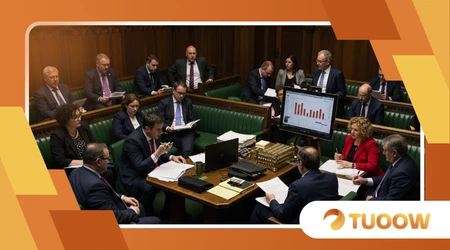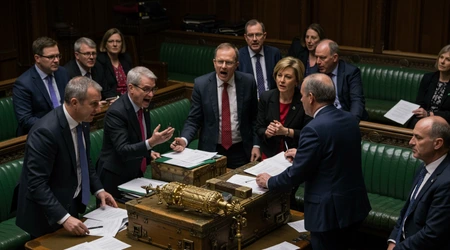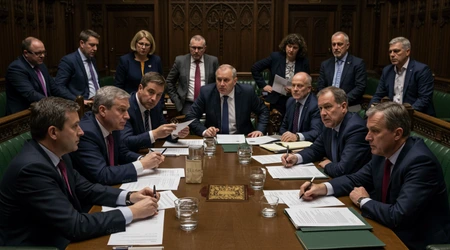Labour Rebellion: Inside MPs’ Pushback Against Welfare Reform

Labour rebellion has rocked Westminster, exposing deep rifts within the party over welfare reforms.
In 2025, Keir Starmer’s government faces its biggest internal challenge yet, as over 120 Labour MPs initially backed an amendment to halt the Universal Credit and Personal Independence Payment (PIP) Bill, set for its Second Reading on July 1, 2025.
This revolt, sparked by proposed cuts to disability benefits, reveals not just policy disagreements but a broader struggle over Labour’s identity.
What follows is an exploration of the rebellion’s roots, its implications, and the government’s response, weaving through the voices of MPs, the public, and the data driving this contentious debate.
The labour rebellion isn’t merely a parliamentary squabble; it’s a clash of values. Labour MPs, elected to champion fairness, find themselves at odds with a leadership pushing fiscal restraint.
The bill, aimed at saving £5 billion by 2030, tightens eligibility for PIP and reduces Universal Credit’s health-related payments.
Critics argue it risks pushing vulnerable people into poverty. Health Secretary Wes Streeting admitted on Sky News, “There were things we didn’t get right,” signaling concessions after intense backbench pressure.
This article unpacks the rebellion’s dynamics, offering a lens into Labour’s internal fractures and the broader welfare debate.
The Roots of the Labour Rebellion
Discontent simmered long before the labour rebellion erupted. Labour’s manifesto promised a fairer welfare system, but MPs like Nadia Whittome argue the bill betrays that pledge.
The proposed cuts, they say, target the most vulnerable disabled people and those with long-term health conditions. An amendment, led by Dame Meg Hillier and signed by 126 MPs, sought to block the bill, citing inadequate impact assessments.
This wasn’t just about policy; it was about Labour’s soul. MPs didn’t enter politics to impoverish constituents, as Whittome tweeted on June 30, 2025.
The rebellion’s scale surprised No. 10. Over 120 MPs, including new intakes, rallied against the bill, fearing it would harm their constituencies.
For example, in Greater Manchester, Mayor Andy Burnham called the reforms “half a U-turn,” urging MPs to reject them entirely.
The government’s initial focus on financial savings projected to curb a £70 billion welfare bill by 2030 alienated backbenchers who wanted a moral case for reform.
The labour rebellion reflects a disconnect between Starmer’s pragmatic leadership and the party’s idealistic base.
This isn’t the first time welfare reforms have split Labour. Historical rebellions, like those under Tony Blair in 1997, saw 47 MPs defy the whip over similar issues. Today’s revolt, potentially involving 50 MPs even after concessions, dwarfs those numbers.
The labour rebellion draws strength from a coalition of new and veteran MPs, united by a shared unease.
They argue the bill’s rushed timeline and lack of consultation betray Labour’s commitment to social justice, setting the stage for a parliamentary showdown.

The Government’s Response and Concessions
Facing a potential defeat, Starmer’s team scrambled to quell the labour rebellion. Work and Pensions Secretary Liz Kendall announced four major U-turns on June 30, 2025, protecting current PIP claimants and maintaining Universal Credit’s health-related payments in real terms.
These concessions, costing £2.5 billion by 2030, reduced projected savings from £5 billion to £2.5 billion annually.
Kendall insisted the revised bill offers a “fairer, more compassionate system,” but rebels like Vicky Foxcroft remain unconvinced, demanding further changes.
No. 10’s strategy involved intense lobbying. Cabinet ministers personally called rebels, with one MP claiming a minister warned a defeat could trigger a leadership contest.
This heavy-handed approach backfired, fueling resentment. Starmer’s dismissal of the backlash as “noises off” at a NATO summit further inflamed tensions.
Also read: Blaise Metreweli Appointed as MI6’s First Female Chief in 116-Year History
The labour rebellion exposed a government caught off-guard, struggling to balance fiscal discipline with party unity. Concessions may save the bill, but the damage to Starmer’s authority lingers.
The government’s pivot wasn’t just tactical; it was a response to public and party pressure. For instance, 70 councillors from regions hit hardest by the reforms wrote to Kendall, demanding protections for vulnerable claimants.
The labour rebellion forced a recalibration, but critics argue it’s too little, too late. Official modelling still predicts 150,000 people will fall into poverty by 2030, down from an initial 250,000.
This statistic underscores the rebellion’s partial success but highlights ongoing concerns about the bill’s impact.
The Impact on Vulnerable Communities
The labour rebellion shines a spotlight on those most affected: disabled people and those with chronic illnesses. The original bill proposed slashing PIP eligibility, potentially affecting 800,000 claimants.
For someone like Sarah, a fictional single mother with fibromyalgia, losing PIP could mean choosing between medication and rent.
Rebels argue such cuts erode dignity, trapping people in poverty rather than enabling work. The government counters that reforms aim to boost employment among the 2.8 million economically inactive due to long-term sickness.
Data from the Institute for Fiscal Studies (IFS) paints a stark picture: health-related benefit claimants rose from 3 million in 2019 to 4 million by March 2025, or one in 10 working-age adults.
This surge, coupled with a projected £70 billion welfare bill by 2030, underpins the government’s push for reform.
Read more: Public Transport Price Hike: How It Will Affect Commuters
Yet, rebels like Dame Meg Hillier argue the bill lacks evidence that cuts will lead to jobs. The labour rebellion demands a system that supports, not punishes, the vulnerable.
Consider John, a hypothetical veteran with PTSD, reliant on Universal Credit’s health component. The initial proposal to cut this payment to £50 weekly sparked outrage among MPs, who saw constituents like John facing destitution.
Even with concessions, the labour rebellion insists the bill fails to address structural barriers to employment, like inadequate mental health support.
The rebellion’s moral argument resonates with voters, who see welfare as a safety net, not a trap.
Political Fallout and Starmer’s Leadership
The labour rebellion tests Starmer’s grip on power. A year after a landslide victory, his authority faces scrutiny. The Conservatives, led by Kemi Badenoch, seized the moment, announcing they’ll oppose the bill, citing Starmer’s failure to commit to broader welfare savings.
This leaves Labour reliant on its own MPs, with estimates suggesting 50 rebels could still defy the whip. The rebellion’s scale potentially the largest of Starmer’s premiership signals deeper unrest within the party.
Starmer’s defenders argue he’s tackling a broken system. At a NATO summit, he insisted, “We were elected to change that which is broken.”
Yet, his initial refusal to budge alienated MPs, who felt ignored. The labour rebellion isn’t just about welfare; it’s about how Starmer leads.
Critics, like those quoted in The Guardian, fault No. 10 for prioritizing public opinion over parliamentary support. The rebellion could embolden future challenges, weakening Labour’s cohesion.
The fallout extends beyond Westminster. Public sentiment, reflected in anti-austerity protests in London last month, aligns with the rebels’ concerns.
If the bill passes with minimal rebellion, Starmer may regain momentum. But a significant revolt could tarnish his image as a unifying leader.
The labour rebellion is a crucible, testing whether Starmer can navigate ideological divides while delivering on his manifesto promises.
The Broader Welfare Debate

Beyond the labour rebellion, the welfare debate raises bigger questions. Can a system bloated by rising costs remain sustainable without reform?
The government argues no, pointing to a ballooning welfare budget. Yet, rebels counter that savings shouldn’t come at the expense of the vulnerable.
The IFS data highlights the challenge: health-related benefits now account for a growing share of public spending, straining fiscal resources. The rebellion forces a reckoning with these trade-offs.
Imagine a ship taking on water reforms are the crew bailing out, but rebels argue the holes need patching first. This analogy captures the divide: Starmer sees urgent action to lighten the load, while MPs demand structural fixes.
The labour rebellion underscores a broader tension in Labour’s ethos balancing fiscal responsibility with social justice. Without consensus, the party risks alienating both voters and its base.
The debate also reflects global trends. Austerity measures across Europe face similar pushback, as citizens demand protection for social safety nets.
In the UK, the labour rebellion could set a precedent for how governments navigate welfare reform in an era of economic strain.
The outcome of the July 1 vote will shape not just Labour’s future but the national conversation on fairness and opportunity.
Table: Key Statistics on UK Welfare Reforms (2025)
| Metric | Original Proposal | Revised Proposal (Post-Concessions) |
|---|---|---|
| Annual Savings by 2030 | £5 billion | £2.5 billion |
| People Pushed into Poverty | 250,000 | 150,000 |
| PIP Claimants Affected | 800,000 | Current claimants protected |
| Universal Credit Health Payment | £50/week | Maintained in real terms |
Source: Institute for Fiscal Studies and Government Impact Assessment, June 2025
Conclusion
The labour rebellion is more than a policy dispute; it’s a defining moment for Labour and Starmer’s leadership. As the July 1 vote looms, the party stands at a crossroads. Will it unite behind a compromised bill, or will dissent fracture its majority?
The rebellion’s roots discontent over cuts, distrust in leadership, and a moral stand for the vulnerable reflect Labour’s enduring struggle to balance principle with pragmatism.
Concessions have softened the bill’s edges, but the projected 150,000 people still facing poverty keep the issue alive.
This crisis demands reflection. Why should vulnerable communities bear the brunt of fiscal reform? The labour rebellion challenges Labour to redefine its vision for welfare one that uplifts, not undermines, the disadvantaged.
As Starmer navigates this storm, his ability to listen and adapt will shape his legacy. The rebellion may fade, but its echoes will resonate, urging Labour to rebuild trust with its MPs and the public.
The vote’s outcome will signal whether Starmer can steer Labour through turbulent waters or if the party’s divisions will deepen.
Frequently Asked Questions
1. What triggered the Labour rebellion over welfare reform?
The rebellion stemmed from proposed cuts to PIP and Universal Credit, which MPs feared would push vulnerable people into poverty, prompting 126 to back an amendment.
2. How has the government responded to the rebellion?
The government offered four concessions, costing £2.5 billion, protecting current PIP claimants and Universal Credit payments, but some rebels remain unsatisfied.
3. Will the welfare bill pass despite the rebellion?
With Labour’s 165-seat majority, the bill is likely to pass, though up to 50 MPs may still rebel, marking Starmer’s largest challenge yet.
4. What are the broader implications of the rebellion?
The rebellion exposes tensions in Labour’s identity, testing Starmer’s leadership and shaping public trust in the party’s commitment to social justice.
